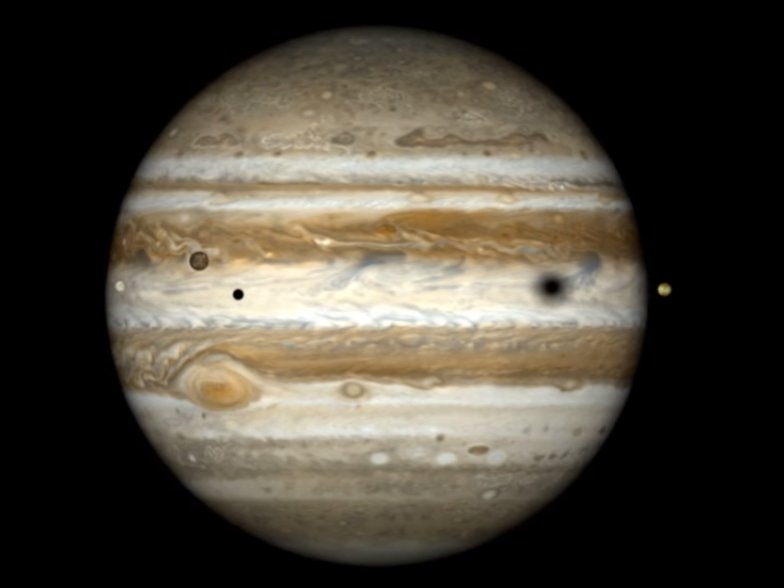

Our solar system boasts many strange and wonderful worlds, none of which match Jupiter in size or in strangeness. This gargantuan beast spans many millions of miles across, and has acquired well over 60 moons over the course of its life, but it has a much softer side; it protects Earth from harm by gobbling up potentially life-extinguishing comets and asteroids.
Naturally, moons transit the face of Jupiter relative to Earth regularly, but in an extremely rare event, tomorrow, not one, or even two, but three moons will pass across the face of Jupiter from our vantage point: a celestial event that won’t happen again for almost 20 years.
If you’re lucky enough to live in the central Los Angeles area, Griffith Observatory (in Los Feliz, CA) will host a live event. You can learn more in the press release below:
A rare celestial event will take place on Friday, January 23, 2015, when the shadows of three of Jupiter’s largest moons will fall upon Jupiter at the same time. The shadows of these three moons — Io, Europa, and Callisto — will cross Jupiter’s disk throughout the evening. Three moon shadows will not appear simultaneously on Jupiter again, as seen from the United States, until 2032. An animation that shows what the triple-shadow transit will look like can be seen below.
WATCH: “Animation of Jupiter Triple Moon Shadow Transit, January 23, 2015”

WHAT: Griffith Observatory will provide a live online broadcast of the Jupiter triple-shadow transit on its Livestream channel (which can be found here). The webcast will begin at 8:30 p.m. PST and conclude at 11:00 p.m. PST. A time-lapse video of the event will be available in the days that follow the event on Griffith Observatory’s YouTube channel.
Telescopes from the Los Angeles Astronomical Society and the Planetary Society will join Griffith Observatory’s telescopes to witness the event starting at 7:11 p.m. Griffith Observatory will close as usual at 10:00 p.m., but the lawn will remain open until 11:00 p.m. The inbound Griffith Park gate at Vermont Avenue will also close at 10:00 p.m., as usual, but visitors who are already at Griffith Observatory may remain through the end of the triple-shadow transit.
The Observatory’s regular monthly star party will be held the following night, January 24, 2015, during which time visitors will be able to see the planets Mercury, Venus, Mars, Uranus, and Neptune, as well as the Moon and comet Lovejoy, C/2014 Q2.
WHERE: Griffith Observatory, 2800 East Observatory Road, Los Angeles, CA 90027.
WHEN: Friday, January 23, 2015, from 8:30 p.m. to 11:00 p.m. PST (live webcast) [Note: PST is 8 hours behind UTC/GMT, so the event begins at 04:30 UTC/GMT on January 24th.]